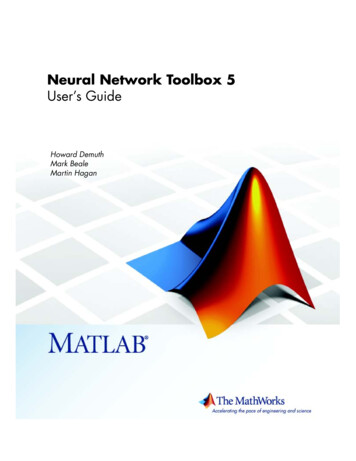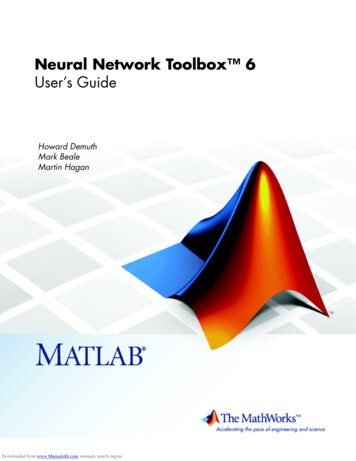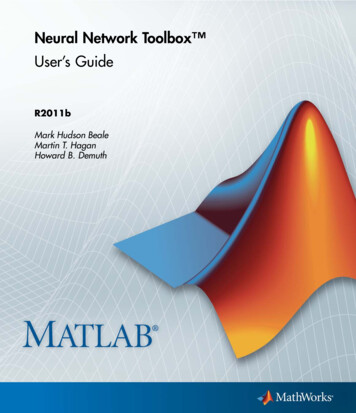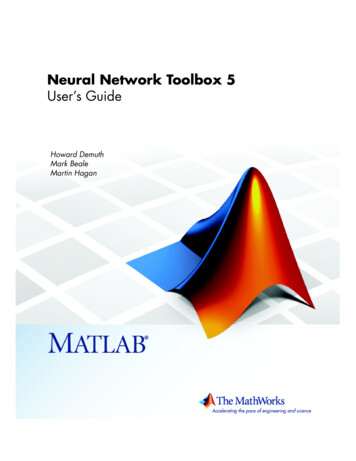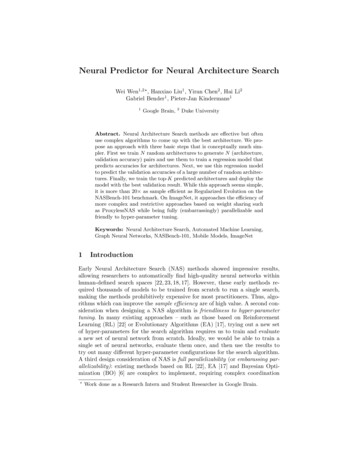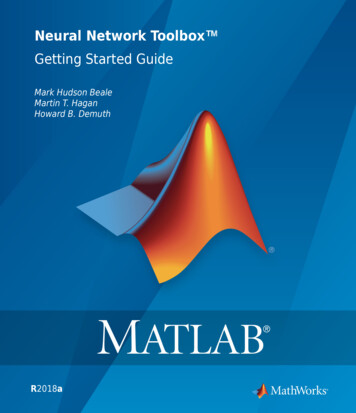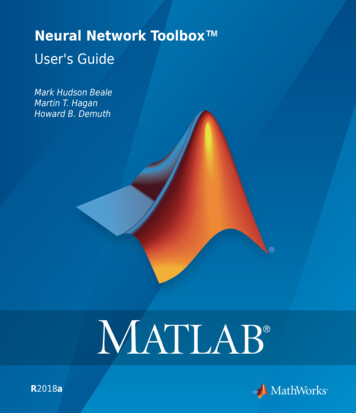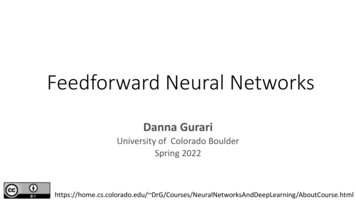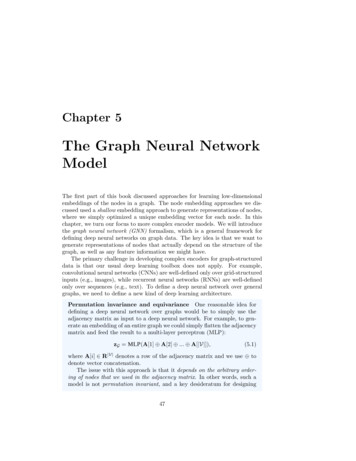
Transcription
Large-scale Neural Modelingin MapReduce and GiraphShuo YangNicholas D. SpielmanBrad S. RubinJadin C. JacksonGraduate Programs in SoftwareDepartment of BiologyGraduate Programs in Software Neuroscience ProgramUniversity of St. ThomasUniversity of St. ThomasUniversity of St. ThomasUniversity of St. Thomasbsrubin@stthomas.eduspie6388@stthomas.edu tract—One of the most crucial challenges in scientificcomputing is scalability. Hadoop, an open-source implementationof the MapReduce parallel programming model developed byGoogle, has emerged as a powerful platform for performinglarge-scale scientific computing at very low costs. In this paper,we explore the use of Hadoop to model large-scale neuralnetworks. A neural network is most naturally modeled by agraph structure with iterative processing. In this paper, wefirst present an improved graph algorithm design pattern inMapReduce called Mapper-side Schimmy. Experiments show thatthe application of our design pattern, combined with the currentbest practices, can reduce the running time of the neural networksimulation on a neural network with 100,000 neurons and 2.3billion edges by 64%. MapReduce, however, is inherently notefficient for iterative graph processing. To address the limitationof the MapReduce model, we then explore the use of Giraph, anopen source large-scale graph processing framework that sits ontop of Hadoop to implement graph algorithms with a vertexcentric approach. We show that our Giraph implementationboosted performance by 91% compared to a basic MapReduceimplementation and by 60% compared to our improved Mapperside Schimmy algorithm.I.I NTRODUCTIONThere is a growing need for computational scientists toperform their scientific computing at a large-scale which iswell beyond the capabilities of an individual machine orworkstation. Traditionally, supercomputers are used to achievethis, but access to supercomputers is limited and expensive.Fortunately, with the emergence of Apache Hadoop1 , an opensource implementation of the MapReduce parallel programming model [1], these needs may be met using commodityhardware at very low cost. MapReduce is a processing architecture for large-scale data processing developed by Google. Inthis paper, we investigate using Hadoop to model a large-scaleneural network. Unlike well-known problems in areas likesocial networking and web connectivities, the use of Hadoop inscientific computing for fields like computational neurosciencehas not gained much traction. We hope this paper encouragesfurther exploration into using Hadoop to tackle large-scalecomputing problems in these fields.The graph model is an intuitive way of modeling many realworld problems, such as the PageRank problem [5]. We canuse the MapReduce model to process large-scale graphs, suchas neural networks. In [2], Lin and Schatz proposed severalenhanced design patterns for MapReduce graph algorithms.1 ApacheHadoop. http://hadoop.apache.org/These represent the current best practices for large-scale graphprocessing in MapReduce.Based on these current best practices, we propose anenhanced design pattern that can be used in a large classof graph algorithms based on message passing. While theseimprovements proved to be effective, they could not addresssome of the fundamental limitations of the MapReduce modelfor graph processing. After briefly discussing these limitations,we turn to another approach: a vertex-centric abstraction basedon the bulk-synchronous parallel (BSP) model [3], which fitswell for iterative graph processing. We use an open sourcegraph processing framework Giraph2 to implement the vertexcentric graph algorithm. Finally, we summarize our work andgive future directions.II.N EURON M ODELNeurons are information-processing cells that connectthrough synapses with other neurons to form networks whosecoordinated activity is responsible for computational processessuch as cognition, sensory processing, decision-making, actionselection, and reflexes in humans and other animals. A singleneuron’s functional state can be largely characterized by theelectrical potential of its membrane, which changes in responseto synaptic inputs from other neurons. These synaptic connections from other neurons can be either excitatory, providingpositive current, or inhibitory, providing negative current. Thestrength of the current depends on the strength, or weight,of the synapse that was activated, and the direction of thecurrent, positive or negative, will raise or lower, respectively,the membrane potential. When the membrane potential reachesa critical, threshold value, an all-or-nothing electrical eventcalled an action potential or “spike” is produced by the neuron.The spike causes the neuron to activate the synapses of neuronsto which it sends connections, thereby activating positive ornegative currents in these downstream neurons depending onthe type of synapse. Following an action potential, a neuron’sstate is reset, returning the neuron’s membrane potential tobaseline.Neuroscientists routinely use computational models to explore how the brain functions. In this paper we use the hybridneural model described by Izhikevich [4],dv 0.04v 2 5v 140 u Idt2 ApacheGiraph. http://giraph.apache.org/(1)
du a(bv u)dtwith the auxiliary after-spike resetting, v cif v 30mV, thenu u d2)(2)3)(3)Applying these three steps into MapReduce, each iterationis a single MapReduce job. Step-1 is naturally implementedin a Mapper while step-3 is implemented in a Reducer. Aprogrammer does not have to worry about step-2 since itis taken care of by the MapReduce framework itself. Morespecifically, for the neural model mentioned in section 2,consider a sample neural network where three neurons N1, N2and N3 are connected with each other in Figure 1-A. Figure1-B illustrates the three-step processing for one iteration.This represents a simple spiking neural model that is asbiologically plausible as the Hodgkin-Huxley model, yet ascomputationally efficient as the integrate-and-fire model [4].Here v represents the membrane potential of the neuron andu represents the membrane recovery variable that providesnegative feedback to v. After the spike reaches its apex( 30mV), the membrane potential and the recovery variableare reset according to the equation (3). Synaptic currents orinjected DC-currents are delivered via the variable I.ANote that in this paper we do not focus on evaluatingthe model itself, instead, we take it as an application caseto explore how open source big data technology like Hadoopcan be used to compute the model at a large scale.}From a computer science perspective, the neuron, itself,is the vertex, and the edges represent directional synapticconnections between neurons. Next, we will describe in moredetail how we modeled the neural network with MapReduceand Giraph.III.partial results in the form of arbitrary messages arepassed via directed edges to each vertex’s neighbors;computations occur at every vertex based on incoming partial results, potentially altering the vertex’sinternal state.N.v memb. voltageN.u recoveryN.aN.bParametersN.cN.dN.I Input currentN.SynapticWeightSumN.neighborsBG RAPH A LGORITHMS IN M AP R EDUCEA. Overview of MapReduceMapReduce is a parallel programming model for largescale data processing developed by Google. Inspired by themap and reduce functions commonly used in functionalprogramming, it abstracts away messy details in distributedprogramming (such as synchronization, scheduling and faulttolerance) and simply leaves programmers with two mainabstractions: Mapper and Reducer. Mappers take key-valuepairs as processing primitives and produces intermediate keyvalue pairs, which are then automatically sorted, shuffled andpassed to Reducers by the MapReduce framework, such thatall the values associated with the same key are grouped in alist and fed to a Reducer. Each Reducer then aggregates theseinputs and generates arbitrary key-value pairs as output. BothMappers and Reducers operate in parallel, and can thus processlarge-scale datasets efficiently.CIntermediate FilesReducer XMapper BIntermediate FilesReducer YFig. 1: A sample neural network simulated in MapReduce(A) an example of three interconnected neurons, with neuron N1sending ouput connections to N2 and N3, and receiving input synapticconnections from N2 and N3. The parameters for each neuron canbe encapsulated in a single structure with elements for membranevoltage, a recovery variable, dynamic parameters, and connectivity.(B) each simulation iteration is composed of three distinct steps: theMap step where the state of each neuron is updated and messages (i.e.spikes) are generated to be sent to its neighbors depending on the stateof each neuron’s membrane voltage variable; the Shuffle-sort step,which combines messages to the same neighbor and partitions themessages to be sent to the reducers; and, Reduce step which appliesthe incoming messages from a neuron’s neigbors to that neuron’slist of active inputs. (C) the hardware-level I/O involved in eachprocessing step in (B) means that there is one read and one writeto disk for each Map step and one read and one write to disk foreach Reduce step.B. The general pattern of graph processing in MapReduceMapReduce provides an enabling technology for largescale graph processing. In MapReduce, we can representa graph by key-value pairs. Keys denote vertices with anidentifier and some associated metadata while values compriselocal graph structure. The types of the key and value can be aprimitive type (e.g. IntWritable, FloatWritable in Hadoop) ora complex object (e.g. custom writable in Hadoop).Many graph algorithms are by nature iterative, includingPageRank and the neural model we just introduced. At eachiteration, the processing can be broken down into three steps[2]:1)Mapper Acomputations occur at every vertex as a function ofthe vertex’s internal state and its local graph structure;To fully implement this neural network as a graph algorithm in MapReduce, we need to chain the same MapReduce2
job together until a certain criterion is reached; in our case, thecomputation stops when the maximum number of iterations, ortime steps has been reached. The implications of this iterativepattern are diagrammed in the Figure 1-C.the neuron structure itself. We need a function IsNeuron()to distinguish between weight messages and neuron structure.The reducer finally updates the synaptic summation field of theneuron with the total weights emitted to a neuron, and writesthe neuron data to the underlying HDFS, making it availableas input for the next iteration’s mapper. This is step-3. EachMapReduce job corresponds to one iteration of the algorithm.C. Basic graph algorithmSahai and Sahai [6] gave a detailed illustration on how toimplement the basic graph algorithm in MapReduce for theneural model. We restate it in Algorithm 1.D. Current best practices of graph algorithm in MapReduceIn [2], Lin and Schatz proposed two improved designpattern of graph algorithms in MapReduce which are InMapper Combining (IMC) and Schimmy. These are the currentbest practices for larges-scale graph processing in MapReduce.In this section we will give a brief review of both.A LGORITHM 1: Basic Graph Algorithm in MapReduceclass Mappermethod map (id n, neuron N)GenerateThalamicInput (N)UpdateInternalState (N)if N.v 30 thenforeach edge N.neighbors() doEmit (edge.id, edge.weight)N.v N.cN.u N.u N.dEmit (id n, neuron N)1) In-Mapper Combining (IMC): A large class of graphalgorithms in MapReduce share a simple feature: mappersperform some computations on each vertex and emit messagesto some of its neighbors. Reducers then group those messagesin some fashion and then update the vertex’s internal state.However, local aggregation can be done on messages beforesending them to reducers in order to reduce the network trafficbetween map and reduce.class Reducermethod reduce (id n, [w1, w2, . . .])sum 0neuron N foreach w [w1, w2, . . .] doif IsNeuron(w) thenN welsesum sum wAlgorithm 2 shows the improved graph algorithm usingIMC.A LGORITHM 2: Graph Algorithm using IMCN.SynapticWeightSum sumEmit (id n, neuron N)class Mappermethod setup ()H AssociativeArrayfunction GenerateThalamicInputif N.type ’Excitatory’ thenN.I 5 Random([-1, 1])elseN.I 2 Random([-1, 1])method map (id n, neuron N)GenerateThalamicInput (N)UpdateInternalState (N)if N.v 30 thenforeach edge N.neighbors() doH{edge.id} H{edge.id} edge.weightN.v N.cN.u N.u N.dEmit (id n, neuron N)method cleanup ()foreach id n H doEmit (id n, value H{n})function UpdateInternalState(neuron N)N.I N.I N.SynapticWeightSumN.v N.v 0.5 (0.04 N.v2 5 N.v 140-N.u N.I)N.v N.v 0.5 (0.04 N.v2 5 N.v 140-N.u N.I)N.u N.u N.a (N.b N.v-N.u) N.SynapticWeightSum 0N.time N.time 1Note that the above pseudocode is just a high-level description of the algorithm. Also, note that we abstract thethalamic input generation and internal neuron state processinginto two helper functions and we will not mention them inthe upcoming improved MapReduce graph algorithm. Thealgorithm corresponds to the three steps mentioned before.The network graph is constructed as key-values pairs in whichthe key is a unique id to identify a neuron and the valuerepresents the internal state of a neuron and its local structure.These pairs are sent to each mapper as input. The mapperperforms computations in step-1 where each individual neuronis processed and its internal state is updated. The entire neuronstructure is passed to the reducers and if the neuron fires, it willalso send synaptic weight messages to all its neighbors. Thiscorresponds to step-2, where message shuffling and sortingoccurs. The MapReduce framework takes care of routing ofmessages to ensure values associated with the same key aregrouped together and delivered to the same reducer. In thereducer, all weight messages that are destined to the sameneuron arrive together and are summed, and also includePrior to processing any key-value pairs, the mapper firstcalls the setup method to initialize an instance of an associativearray (e.g. a HashMap in Java) which maps a set of keys toa set of values. This associative array is updated whenever aneuron fires. However, emitting the messages is deferred to thecleanup phase where all messages with the same destinationneuron have been aggregated, thus only a single messageis emitted for each neuron. The downside of the IMC isthe extensive usage of the local memory, which can causeswapping and become a performance bottleneck. Note that inthe IMC pattern, the reducer code remains unchanged.2) Schimmy: In the basic graph algorithm or IMC, thegraph structure will be passed and shuffled across the network. This is very undesirable for the large graph datasetsbecause the graph structure is usually much larger than themessages passed along the graph edges. Schimmy is designedfor avoiding the shuffling of the graph structure. It is inspired3
graph partitions reside on the underlying distributed file system(HDFS for Hadoop) and the MapReduce runtime systemarbitrarily assigns reducers to cluster nodes. This is potentiallya performance bottleneck. The Schimmy pattern works wellfor the PageRank problem as discussed by Lin and Schatz in[2], but as we will see later, in our case, it does boost theperformance.by a well-known join-technique in the relational database fieldcalled a parallel merge join [7]. Suppose two relations, S andT , were both partitioned (in the same manner by the join key)into ten files and in each file, the tuples were sorted by thejoin key. In this case, we simply need to join the first file ofS with the first file of T , etc. These merge joins can happenin parallel. Schimmy applies this idea in MapReduce graphprocessing by partitioning the graph into n parts, such that agraph G G1 G2 . . . Gn , and within each part, vertices aresorted by vertex id. Hadoop provides a Partitioner interface forusers to write their custom partitioner, therefore as long as weuse the same partition function for partitioning the graph in theMapReduce graph algorithm, and set the number of reducersequal to the number of input partitions, Hadoop’s MapReduceruntime system guarantees that the intermediate keys (vertexids) processed by the reducer R1 are exactly the same as vertexids in G1 and sorted in the same order; the same for R2 andG2 until Rn and Gn . Further, the intermediate keys in Rnrepresent messages passed to each vertex, and Gn key-valuepairs comprise the graph structure. Therefore, a parallel mergejoin between Rn and Gn can merge the results of computationsbased on message passed to a vertex and the vertex’s localstructure, thus enabling the update of the vertex’s internal state.In doing this we no longer need to shuffle the graph structureacross the network. Algorithm 3 illustrates the MapReducealgorithm with Schimmy implemented for the neural model.3) Improved graph algorithm design pattern - Mapper-sideSchimmy: Inspired by the Schimmy pattern, we found thatnot only shuffling the graph structure is unnecessary, but inmany algorithms, the graph structure itself is read-only. InSchimmy, the reducer remotely reads the graph structure andwrites it back to the distributed file system after updating thevertex’s internal state. To avoid the often unnecessary stepof writing out the graph structure, we propose an improveddesign pattern: Mapper-side Schimmy, where we move theSchimmy to the mapper side and separate the vertex’s internalstate with the read-only graph structure such that the graphstructure is read only once by the mapper and the reducer’stasks are simplified. This idea is illustrated as pseudo-code inthe Algorithm 4.A LGORITHM 4: Mapper-side Schimmyclass Mappermethod setup ()G.OpenGraphPartition()method map (id n, NeuronState N)GenerateThalamicInput (N)UpdateInternalState (N)if N.v 30 thenrepeat(id m, neuron M) G.Read()until n m;foreach edge M.neighbors() doEmit (edge.id, edge.weight)N.v N.cN.u N.u N.dEmit (id n, NeuronState N)A LGORITHM 3: Graph Algorithm with Schimmyclass Mappermethod map (id n, neuron N)GenerateThalamicInput (N)UpdateInternalState (N)if N.v 30 thenforeach edge N.neighbors() doEmit (edge.id, edge.weight)N.v N.cN.u N.u N.dclass Reducermethod setup ()G.OpenGraphPartition()class Reducermethod reduce (id n, [w1 , w2 , . . .])sum 0foreach w [w1 , w2 , . . .] doif IsNeuronState(w) thenN welsesum sum wmethod reduce (id m, [w1 , w2 , . . .])sum 0repeat(id n, neuron N) G.Read()if n 6 m thenEmit (id n, neuron N)until n m;foreach w [w1 , w2 , . . .] dosum sum wN.SynapticWeightSum sumEmit (id n, neuron N)N.SynapticWeightSum sumEmit (id n, neuron N)As we can see, in the Mapper-side Schimmy design pattern,a mapper no longer takes the entire graph structure as thevalue, instead, the value only contains a neuron’s internalstate (N euronState). It remotely reads the graph partitioncorresponding to the input key-value pairs. Note that, just likeSchimmy, we must use the same partition function for partitioning the graph as the partitioner in the MapReduce graphalgorithm, and set the number of reducers equal to the numberof input partitions. In the reducer, we still need a function(IsN euronState) to distinguish between the synaptic weightand the neuron’s internal state. By moving the Schimmy to themapper side and separating the read-only graph structure withthe vertex’s internal state, we eliminate the need of writing theentire graph structure back to the distributed file system. TheNote that the mapper code remains nearly unchangedexcept for the deletion of the line emitting the graph structure.The reducer first opens the corresponding graph partitionin the setup method. Then it advances through the graphstructure until the corresponding vertex’s structure is found.After jumping out of the loop, the vertex’s internal state isupdated and written back to the file system. The partitionerensures consistent partitioning of the graph structure fromiteration to iteration.Although Schimmy eliminates the graph structure shuffling, it introduces remote file reading, as files containing4
Agraph structure is, therefore, only read once with this pattern.IV.G RAPH A LGORITHM IN G IRAPHAlthough MapReduce is an enabling technology for largescale graph processing, it is far from ideal. No matter how weimprove the design pattern for graph algorithms, MapReduceis not a suitable model for iterative graph processing perse. First, it is unnecessarily slow because each iteration isa single MapReduce job with lots of overhead, includingscheduling, reading the graph structure from disk, and writingthe intermediate results to the distributed file system. Second,the MapReduce abstraction is not intuitive for expressing graphalgorithms as programmers have to “think in key-value pairs”in designing graph algorithms, thus making algorithms hard toimplement and code hard to read and understand. Finally aswe found in the Schimmy pattern and Mapper-side Schimmypattern, the best strategy is data dependent and, therefore, hardto generalize.BBarrierSyncAs an alternative to the MapReduce model, we find thatthe vertex-centric approach is more powerful than MapReducein expressing iterative graph algorithms. It employs a “thinklike-a-vertex” programming model to support iterative graphcomputation. Each vertex is a single computation unit, whichcontains its internal state and all outgoing edges. Thus, theabstraction is made on a vertex-centric level, which is moreintuitive for graph algorithms. The computation for a vertexinvolves receiving messages from its incoming edges, updatingits internal state and sending the messages to other verticesalong its outgoing edges.BarrierSyncFig. 2: BSP Model applied to Graph processing with a vertexcentric approach(A) the barrier synchronization processing (BSP) model waits forprocessing for different computations within an iteration to completeand send out their messages before beginning processing the nextiteration, this forced wait comprises a barrier synchronization andsegregates processing within each iteration into a single Superstep.(B) this BSP model lends itself well to a vertex-centric approachwhere all of the computations for a single neuron are performedon a single processor and outgoing messages about that neuron’sactivity are determined and distributed to other neurons before thenext iteration’s superstep begins.Apache Giraph is an open source software framework forlarge-scale graph processing. It is a loose implementationof Google’s Pregel [8]. Both Pregel and Giraph employ avertex-centric programming model. Because Giraph is opensource, we chose Giraph to implement the neural model.Giraph uses Bulk synchronous parallel (BSP) as its executionmodel. A BSP computation consists of a series of globalsupersteps3 . Each superstep consists of three components: 1)concurrent computation: each processor is assigned a numberof vertices and processes in parallel; 2) communication: theprocessors exchange messages between each other; 3) barriersynchronization: when a processor reaches the barrier, it waitsuntil all other processors finish their communications. The BSPmodel is illstrated in the Figure 2-A. Based on vertex-centricmodel and BSP, we can express the processing for the smallneural network in the Figure 2-B.the frameworks like Pregel or Giraph, with different namingconventions.V.R ESULTSFor MapReduce graph algorithms, we implemented fiveversions: 1) basic implementation; 2) IMC; 3) Schimmy; 4)Mapper-side Schimmy; 5) the combination of Mapper-sideSchimmy and IMC. We also have implemented a vertex-centricgraph algorithm with Giraph. We tested our implementationson a Hadoop cluster with 16 worker nodes, 192 map taskcapacity and 96 reduce task capacity, running Hadoop-2.0. Aneural network with 100,000 neurons and 2.3 Billion edgeswas implemented with an approximate size of 24GB (depending on the different implementations). First, we compared therunning time for a 40 ms simulation (40 iterations) among siximplementations (See Figure 3-A).Algorithm 5 shows pseudo-code for the graph algorithm asa vertex-centric model. We can see that the algorithm expressedby a vertex-centric BSP model is more intuitive, because wetreat each vertex as a class and a single computation unit.We limit the simulation to 40 iterations. In each iteration, thecompute method is called, it sums a list of messages sent fromthe previous iteration and updates the neuron’s state, sendingoutgoing messages if the neuron fired. The computation haltsif the maximum number of iterations has been reached.Although Schimmy has been proven to be effective inPageRank applications, it did not boost performance for ourneural model. However, the Mapper-side Schimmy patternimproved performance by 11%. IMC, despite its simplicity,improved performance by 48%. We found that the combinationof Mapper-side Schimmy and IMC produced the best resultamong these five MapReduce implementations and improvedthe performance by 64%. The Giraph implementation showedthe best performance boost, which was 91% compared to theNote that methods like getSuperstep, getV ertexV alue,getEdges, setV ertexV alue and voteT oHalt are provided by3 Bulk synchronous parallel.http://en.wikipedia.org/wiki/Bulk synchronous parallel5
A LGORITHM 5: Graph Algorithm in vertex-centric modelclass NeuronVertexMaxSuperStep 40method compute (messages [m1 , m2 , . . .])if getSuperstep() MaxSuperStep thensum 0foreach w [m1 , m2 , . . .] dosum sum mneuron getVertexValue()neuron.SynapticWeight sumGenerateThalamicInput (N)UpdateInternalState (N)if neuron.v 30mV thenforeach edge getEdges() dosendMessage (edge.getVertexID(),edge.getValue())neuron.v neuron.cneuron.u neuron.u neuron.dsetVertexValue (neuron)elsevoteToHalt()basic MapReduce implementation. Compared to the Mapperside Schimmy IMC implementation, Giraph had a 60%performance improvement.During experiments, we also recorded the running time ofeach iteration in order to see how each implementation performed as the network activity evolved (Figure 3-C). Usually,after approximately the 13th iteration, neurons started firing intensively, which led to huge amount of network traffic. The Basic, Schimmy and Mapper-side Schimmy implementations allsuffered from the increasing network traffic, while Basic IMC,Mapper-side Schimmy IMC and Giraph implementations allbenefited from in-memory computation, with Giraph showingsuperior performance.VI.Fig. 3: Comparison of running times for different graph processing methods(A) comparison of running times of 40 iterations, we use the ”Basic”implementation as a benchmark for measuring the performance. (B)comparion of running times from 20 ms to 40 ms for steady-statenetwork activity. Note that the ranking of computational savings isthe same when considering only steady-state firing.(C) shows howperformances vary for each iteration. After approximately 13 msec,the networks enter full-firing mode, where many more neurons areactive in the network.C ONCLUSIONCompared to Schimmy, this work presents an improvedMapReduce graph algorithm design pattern which has beenshown to be effective in the neural model we implemented. Itcan be applied to a large class of graph algorithms based onmessage passing. One limitation of the Mapper Side Schimmyimplementation, is that it assumes there are no changes inthe synaptic weights between neurons, an important featureof associative learning models. However, we addressed manyinherent limitations of applying the MapReduce model tograph algorithms by exploring another approach, a vertexcentric BSP model, implemented with the open source largescale graph processing framework Giraph. Using Giraph notonly led to better performance, but also reduced the complexity of implementation. Our results suggest that applicationof our Mapper-side Schimmy design pattern and Giraph toother graph processing problems, such as PageRank, couldpotentially boost their performance.[3][4][5][6][7]R EFERENCES[1][2]J. Dean and S. Ghemawat, MapReduce: Simplified data processing onlarge clusters, In Proceedings of the 6th Symposium on OperatingSystem Design and Implementation (OSDI 2004). pages 137-150, SanFrancisco, California, 2004.Jimmy Lin and Michael Schatz, Design Patterns for Efficient GraphAlgorithms in MapReduce, MLG 10. Washington, DC USA, 2010.[8]6Leslie G. Valiant, A bridging model for parallel computation, Communications of the ACM, Volume 33 Issue 8, Aug. 1990.E. M. Izhikevich, Simple model of spiking neurons, IEEE Transactionson Neural Networks, 14(6):1569-1572, 2003.L. Page, S. Brin, R. Motwani, and T. Winograd, The PageRank citationranking: Bringing order to the web, Technical Report 1999-66, StanfordInfoLab, November 1999.Esha Sahai and Tuhin Sahai, Mapping and Reducing the Brain on theCloud, arXiv:1207.4978, August 14, 2012.D. A. Schneider and D. J. DeWitt, A performance evaluation of fourparallel join algorithms in a shared-nothing multiprocessor environment,In Proceedings of the 1989 ACM SIGMOD International Conference onManagement of Data, pages 110-121, Portland, Oregon, 1989.G. Malewicz, M. H. Austern, A. J. Bik, J. C. Dehnert, I. Horn, N. Leiser,and G. Czajkowski, Pregel: a system for large-scale graph processing,In SIGMOD10, pages 135-146, 2010.
Fortunately, with the emergence of Apache Hadoop1, an open source implementation of the MapReduce parallel program-ming model [1], these needs may be met using commodity hardware at very low cost. MapReduce is a processing archi-tecture for large-scale data processing developed by Google. In this paper, we investigate using Hadoop to model a .
